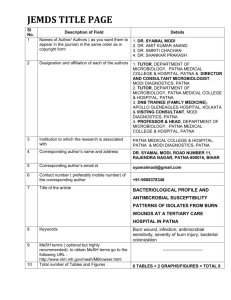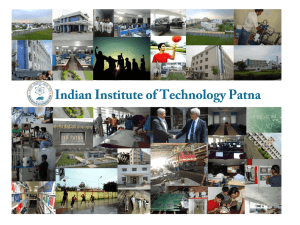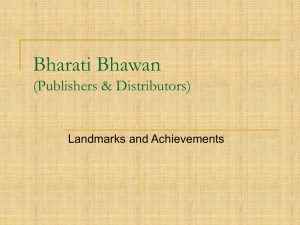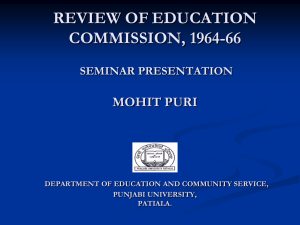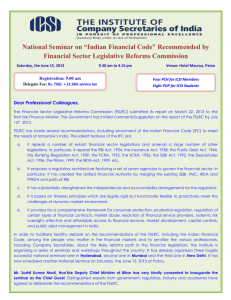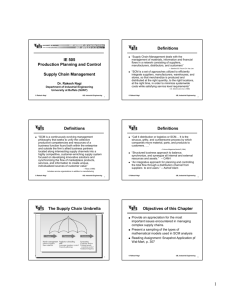34th Indian Geography Congress, Patna 2
advertisement
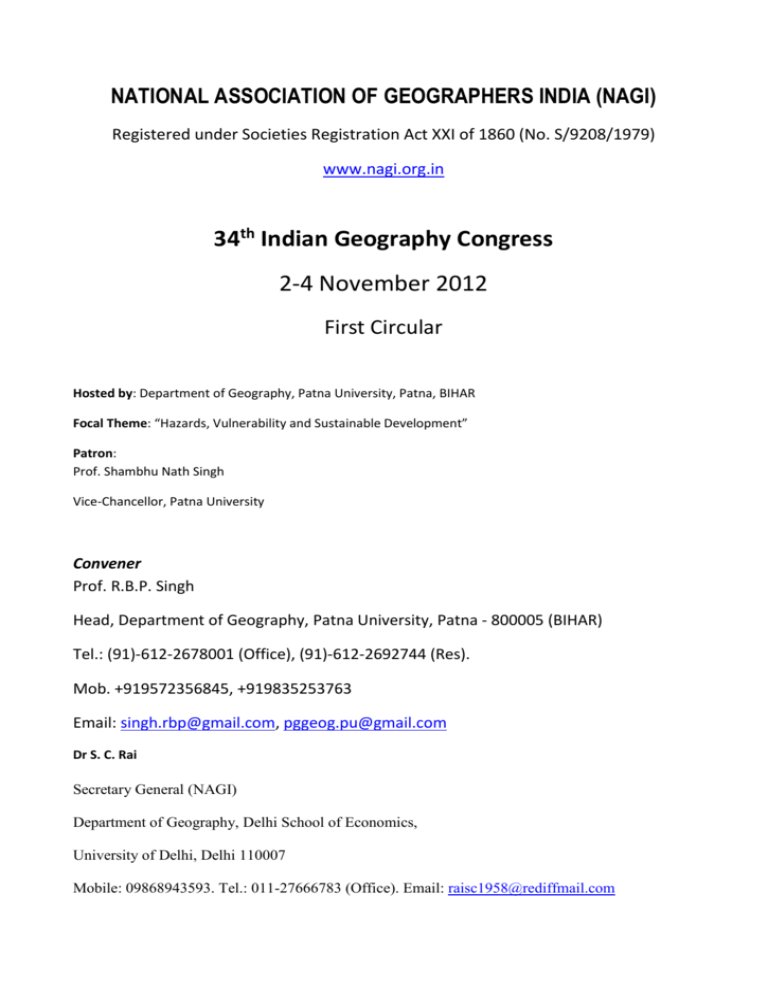
NATIONAL ASSOCIATION OF GEOGRAPHERS INDIA (NAGI) Registered under Societies Registration Act XXI of 1860 (No. S/9208/1979) www.nagi.org.in 34th Indian Geography Congress 2-4 November 2012 First Circular Hosted by: Department of Geography, Patna University, Patna, BIHAR Focal Theme: “Hazards, Vulnerability and Sustainable Development” Patron: Prof. Shambhu Nath Singh Vice-Chancellor, Patna University Convener Prof. R.B.P. Singh Head, Department of Geography, Patna University, Patna - 800005 (BIHAR) Tel.: (91)-612-2678001 (Office), (91)-612-2692744 (Res). Mob. +919572356845, +919835253763 Email: singh.rbp@gmail.com, pggeog.pu@gmail.com Dr S. C. Rai Secretary General (NAGI) Department of Geography, Delhi School of Economics, University of Delhi, Delhi 110007 Mobile: 09868943593. Tel.: 011-27666783 (Office). Email: raisc1958@rediffmail.com ---------------------------CONGRESS THEME "Hazards, Vulnerability and Sustainable Development" India is one of the most disaster-prone areas among the top ten countries in the world. Among all the disasters afflicting the Country, river floods are most frequent and often the mast devastating. Flood affected area increased from an annual average of 6.48 mha in the 1950s to over 90 mha in the 1970s and 1980s. Most of these flood affected areas lie in the Indo-Ganga-Brahmaputra plains are an annual feature and on an average a few hundred lives are lost, millions are rendered homeless and million hectares of crops are damaged every year. The changes in river courses and erosion of river banks are one of the major problems associated with floods. With rapid population growth and development of human settlements in disaster-prone areas, more and more people and their assets are vulnerable to the natural hazards. The number of disasters was three times higher worldwide M the past ten years than that in the 19608. Economic losses were eight times higher, exceeding US$ 60 billion a year. Disaster management is a multidisciplinary area, covering a wide range of issues such as monitoring, forecasting, evacuation, search and rescue, relief, reconstruction and rehabilitation. It also requires multi sectoral governance as scientists, planners, NGOs, and communities all have important roles to play. These roles and activities span the pre, during and post disaster phase. Since their activities are complementary as well as supplementary to each others, there is a critical need for coordination in their actions. Vulnerability refers to the susceptibility of a community to a hazard. The prevailing conditions include physical, socio-economic and political factors that adversely affect its ability to respond to hazards or disaster events. Vulnerability analysis seeks to predict disasters by ensuring timely preparedness on the part of people institutions, and concerned government agencies. The emerging arena of disaster mitigation is becoming an integral aspect of development planning, policy formulation and implementation. Traditionally, disaster management consisted primarily of reactive mechanisms. However, the past few years 'witnessed a gradual shift towards a more proactive, mitigation-based approach, as it was being proved time and again that reactive mechanism yielded only temporary results, at every high cost. In this context, an exploration of the concept of sustainable development inevitably ensures the disaster mitigation. Sustainable development encompasses the three dimensional protection such as economic efficiency, social equity and environmental protection, all three of which contribute to and are affected by natural disaster. In order to reduce the vulnerability, various emerging geographical technologies, i.e. remote sensing, GIS and GPS and infrastructures, that is, human and physical, etc. have to be utilized properly so that maximum-benefits can be extracted from them and vulnerability can be minimized. Mitigation seeks to reduce risk, that is, vulnerability to damages or losses. The reason to focus on mitigating disaster impacts include rising economic and social costs of disasters, existence of technical know-how utilizing emerging areas of science to reduce disaster impacts and costs, and the fact that mitigation is an integral part of sustainable development. Indian subcontinent is highly prone to a number of natural disasters, which need to be addresses and incorporated while formulating a development plan. The 34th Indian Geography Congress (2012) at Patna shall provide a platform to deliberate on the most vital and relevant issues of resources and development. Geographers, planners, decision makers and spatial data analysts shall attempt to bring out the spatial pattern, implications and future directions. Meeting of IGU Commissions/ Plenary Sessions 1. IGU International Year of Global Understanding (IYGU) 2. IGU Commission on Biogeography and Biodiversity Panel Discussion Themes 1. Flood Hazards in Bihar 2. Centre-State Relation and Regional Development Memorial Lectures 1. Prof. R.L. Singh Memorial Lecture (by Prof. Rana P.B. Singh, B.H.U. Varanasi) 2. Prof. Arthur Geddes Memorial Lecture Technical Sessions The technical sessions of the Congress will focus on the following themes: 1. Indian Geography: The Emerging Vistas 2. Geography as a Professional Discipline (Planning, Health Care, Cartography and GIS). 3. Remote Sensing, GPS and GIS in Geographical Studies 4. Physical Geography and Earth System Science 5. Climate Change, Bio-diversity, Environmental Challenges 6. India in the New Global Context 7. People, Resources and Development 8. Urban Society, Economy and Geography 9. From Rural to Urban India 10. Geopolitics, Conflict Resolution and Geography of Peace 11. Social and Cultural Dimensions in Geography 12. Geographical Education Call for Papers On each sub-theme of the Congress, papers will be invited. One invited paper will be presented as keynote address. The keynote address will be followed by papers contributed by the participants. Members are requested to frit up the enclosed registration form and send the same along with the abstract and the registration fee by 15th September, 2012. Full papers must reach the Convener by October 20, 2012. Abstract without full Registration Fee will not be printed in the Book of Abstracts. Manuscript of the full paper should be typed on quarto size and double spaced. Bibliographic reference should be minimized and given at the end of the paper. Geographers are requested to preferably submit only one abstract of paper to the Congress. Registration Fees Registration fee for the participants of the IGC Is Rs. 1000/- out of which Rs. 800/- will be retained by the Convener and the remaining Rs. 200/- wig go to NAGI Secretariat. Participants are requested to sent Rs. 8001- to convener 34th Indian Geography Congress and Rs. 200/-as NAGI share to NAGI Secretariat, Delhi in favour of "the National Association of Geographers, India (NAGI)" along with personal details. For foreign delegates, excluding SAARC, it is $ 126. Research scholars (not below M. Phil Level) would pay Rs. 600/- as registration fee to the Convener and Rs. 200/ - to NAGI Secretariat, provided that their registration form is accompanied by documentary proof of their station. Interested participants are required to become Life or Annual member of the NAGL if you are not a life member, annual membership fee of Rs. 400/- should also be sent to NAGI Secretariat ' together with membership form. Registration fee covers the cost of technical documents, boarding and accommodation in student hostels/institutional Guest houses/ hotels, etc. Family member accompanying the Life and Annual members will pay Rs. 800/- each for boarding and lodging. No documents will be provided to them. Registration fee of Rs. 800/- should be send by M.O./ D.D. to the Convener, 34th Indian Geography Congress. Registration Details Registration Deadlines Up to 30th September 2012 (General) Between P'Oct-November 2012 (General) Up to 15th September, 2012 (RS)* Between 1 Oct-November 2012 (RS)* Senior Geographers (Over 65 years of age) Host NAGI Total Rs. 800/- Rs. 200/- Rs. 1000/- Rs. 1200/- Rs. 200/- Rs. 1400/- Rs. 600/- Rs. 200/- Rs. 800/- Rs. 1000/- Rs. 200/- Rs. 1200/- Rs. 100/- ---- Rs. 100/- *Research Scholars Prof. N.P. Ayyar Young Geographers Award Scheme This award has been instituted by NAGI and is restricted to members who are qualified Geographers within the age limit of 35 years at the time of submission of paper. The paper should be an original research contribution and submitted in 3 copies to the Secretary General, NAGI, so as to reach the Secretariat by October 15, 2010 by registered post/courier. The paper should be written in English, Hindi language only. The participant should also submit his/her detailed resume (3 copies). An Expert Committee will be appointed by NAGI to evaluate the paper contributed and to shortest five best papers among them. The five best papers will be presented in, a special session at IGC and one among them would be finally selected for the young Geographers Award. The awardees will be honored with a cash award of Rs. 1000.00 and a certificate of merit. NAGI Business Meetings NAGI Executive Committee Meeting: 2nd November 2012 at 5.30 P.M. NAGI General Body Meeting: 3rd November 412 at 5.30 P.M. NAGI Executive Committee Meeting: 4th November 2012 at 8.30 A.M. All respective members are requested to attend the same. All above meetings will be held in the Department of Geography, Patna University, Patna. About venue: Patna (Bihar) Patna Urban Agglomeration (2.05 millions in 2011; 25°36′40″ N latitude and 85°08′38″ E longitude; spread over an area of 107 sq. km], is the 18th ranked among the 53 Million+ cities in India, and is the capital of the Indian state of Bihar and the second largest city in Eastern India (in terms of population). Patna is one of the oldest continuously inhabited places in the world. Ancient Patna, known as Pataliputra, was the capital of the Magadha Empire under the Haryanka, Nanda, Mauryan, Sunga, Gupta, Pala and during the Islamic period the seat of power for the Suri dynasty. Pataliputra was also a seat of learning and fine arts. Its population during the Maurya period (around 300 BCE) was about 400,000. The modern city of Patna is situated on the southern bank of the Ganga river. The city also straddles the rivers Sone, Gandak and Punpun. The city is approximately 35 km long and 16 km to 18 km wide. Patna became significant around the year 490 BCE when Ajatashatru, the king of Magadha, wanted to shift his capital from the hilly Rajagrha to a more strategically located place to combat the Licchavis of Vaishali. He chose the site on the bank of the Ganga river and fortified the area. Gautama Buddha passed through this place in the last year of his life. He prophesied a great future for this place, but at the same time, he predicted its ruin from flood, fire, and feud. It is said that Buddha made a halt here when he was on the last journey to his native land of Kapilavastu. The Buddhist, Hindu, and Jain pilgrim centres of Vaishali, Rajgir, Nalanda, Bodhgaya, and Pawapuri are nearby and Patna is also a sacred city for Sikhs as the last Sikh Guru, Guru Gobind Singh, was born here. The city is served by several major road highways and state highways, including National Highways 19, 30, 31, and 83. It is 1,015 kilometres (631 mi) from Delhi, 1,802 kilometres (1,120 mi) from Mumbai and 556 kilometres (345 mi) from Kolkata. Patna, having a fascinating past, is rapidly emerging as a metropolitan city. The City is also emerging as, a hub to explore now emerging economic opportunities. It is well connected by railways, National Highways and air services. Service originates from Patna to almost all major and famous urban destination of India. Patna University Patna University (established in 1917) is the seventh oldest University in this subcontinent. It is a residential University and once its jurisdiction was over entire Bihar, Jharkhand and Odisha. University campus is situated on the right bank of Ganga river giving a phenomenal scenic beauty to the campus. It is a residential University having 31 Post Graduate Departments in the Faculties of Science, Social Science, Humanities, Commerce, Law and Education. There are also ten Constituent Colleges. Patna College, Patna was established in 1863 and most of other colleges have come out from this mother institute. In fact, Post-Graduate Department of Geography is also located within the spacious campus of Patna College, Patna. The University has also well established specialized Post-Graduate Courses in Business Management, Rural Development, Computer Application and Music. All these courses are under the scheme of professional courses. The University has a Directorate of Distance Education having about 20,000 students. There are also well recognised Institutes of Public Administration, Psychological Research and Services and Population Research. Patna University central library has titles being more than one lakh and it is only among a few University libraries in the Country which remains open and accessible round the clock. The University is set to Introduce Semester system at Post Graduate level from the academic session 2012-13. Academic and cultural exchange programmes are in the negotiations with countries like Mauritius France and several others. The University has also planned to develop its 2nd campus in the Saidpur region and UGC la being approached for the purpose. The Department of Geography The Post-Graduate Department of Geography, situated in the specious campus of Patna College, Patna, was established in 1949 with Dr. S.A. Majid as the founder head of the department. Dr. P. Dayal, Dr. S.M. Karimi, Dr. A. Sharan, Dr. R.P. Singh, Dr. L.N. Ram, Dr. E. Ahmed and Dr. K.N. Singh are such geographers of repute at national and international levels who have served the Department and their teaching approach, research methodology and personal affection to teachers, researchers and students have, now, become ethical guidelines and functional inertia to the present faculty members, researchers and pupils. The Department offers MA in Geography, P.G. Diploma in Remote Sensing and GIS and Ph. D. programmes. The major thrust areas of teaching and research are Political Geography, Urban and Regional Planning, Environmental Issues, Population Studies and issues related to Hazards and Disaster Management. Presently, the Department has faculty strength of 10 (Professor 6, Associate Professor 3, and Assistant Professor 1). The Department is awarded SAP-DRS- I in 2010 and the thrust area of research under SAP Scheme is Urban Development Problems and Environmental Degradation in the central plain of India.

